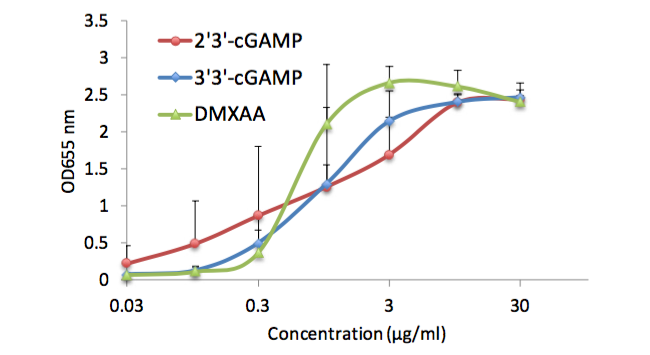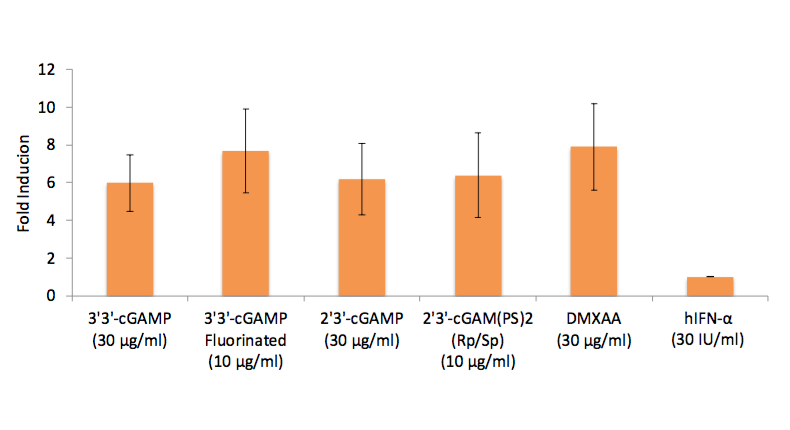293-Dual™ mSTING Cells
| Product | Unit size | Cat. code | Docs. | Qty. | Price | |
|---|---|---|---|---|---|---|
|
293-Dual™ mSTING Cells Dual IRF and IFN-β reporter 293 cells expressing murine STING |
Show product |
3-7 x 10e6 cells |
293d-mstg
|
|
||
|
293-Dual™ mSTING vial Additional cell vial |
Show product |
3-7 x 10e6 cells |
293d-mstg-av
|
Notification: Reference #293d-mstg-av can only be ordered together with reference #293d-mstg.
293-Dual™ mSTING Cells (ISG-SEAP/KI-[IFN-β]Lucia)
293-Dual™ mSTING (ISG/KI-IFNb) cells were generated from 293-Dual™ Null (ISG/KI-IFNb) cells by stable transfection of the murine STING gene.
These cells exhibit a robust response to STING agonists such as 2’3’-cGAMP and 3’3’-cGAMP. In addition, unlike cells with human STING, these cells respond to DMXAA (5,6-Dimethylxanthenone 4-acetic acid) which induces a potent IFN response by activating murine STING [2, 3].
293-Dual™ mSTING (ISG/KI-IFNb) cells are resistant to blasticidin, hygromycin and Zeocin®.
References:
1. Yi G. et al., 2013. Single nucleotide polymorphisms of human STING can affect innate immune response to cyclic dinucleotides. PLoS One. 8(10):e77846.
2. Conlon J. et al., 2013. Mouse, but not human STING, binds and signals in response to the vascular disrupting agent 5,6-dimethylxanthenone-4-acetic acid. J Immunol 190(10):5216-25.
3. Zhang H. et al., 2015. Rat and human STINGs profile similarly towards anticancer/antiviral compounds. Sci Rep. 5:18035.
Specifications
Antibiotic resistance: blasticidin, hygromycin, and Zeocin®
Growth medium: DMEM, 4.5 g/l glucose, 2 mM L-glutamine, 10% (v/v) fetal bovine serum (FBS), 100 U/ml penicillin, 100 μg/ml streptomycin, 100 μg/ml Normocin™
Quality Control:
- Reporter activity has been validated by stimulating the cells with human interferon-β (hIFN-β) and IRF3 activators, such as c-di-AMP and cGAMP.
- The biallelic replacement of the hIFN-β coding sequence with the Lucia luciferase open reading frame (ORF) has been verified by PCR and sequencing.
- The inability to produce IFN-β has been confirmed by ELISA.
- The cell line stability for 20 passages following thawing has been verified.
Guaranteed mycoplasma-free.
Back to the topContents
- 3-7 x 106 of 293-Dual™ mSTING (ISG/KI-IFNb) cells in a cryovial or shipping flask
- 1 ml of Blasticidin (10 mg/ml)
- 1 ml of Hygromycin (100 mg/ml)
- 1 ml of Zeocin® (100 mg/ml)
- 1 ml of Normocin™ (50 mg/ml)
- 1 ml of QB reagent and 1 ml of QB buffer (sufficient to prepare 100 ml of QUANTI-Blue™ Solution, a SEAP detection reagent)
- 1 tube of QUANTI-Luc™ 4 Reagent, a Lucia luciferase detection reagent (sufficient to prepare 25 ml)
![]() Shipped on dry ice (Europe, USA, Canada, and some areas in Asia)
Shipped on dry ice (Europe, USA, Canada, and some areas in Asia)








